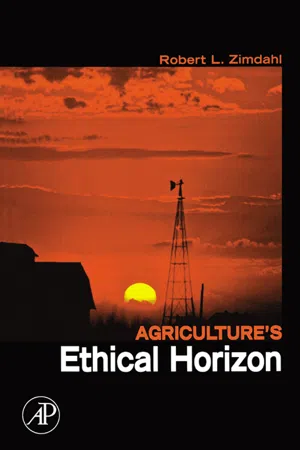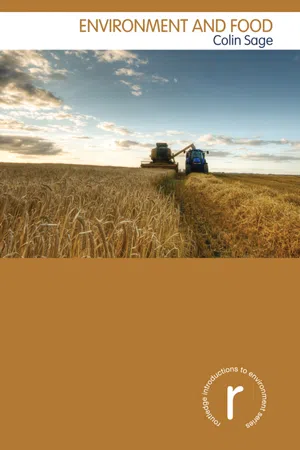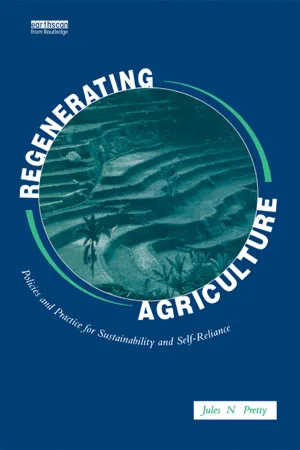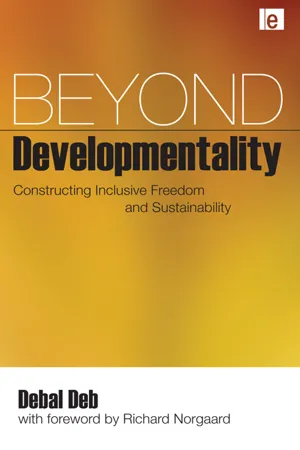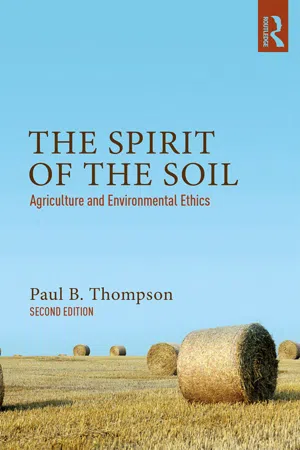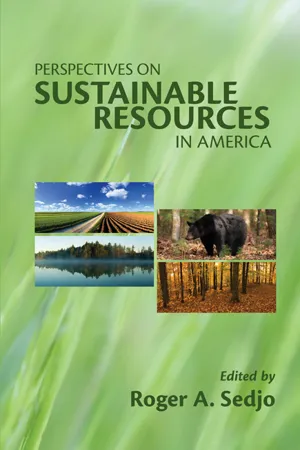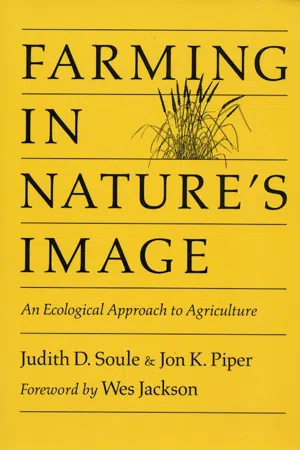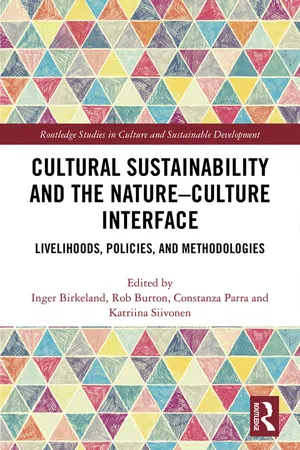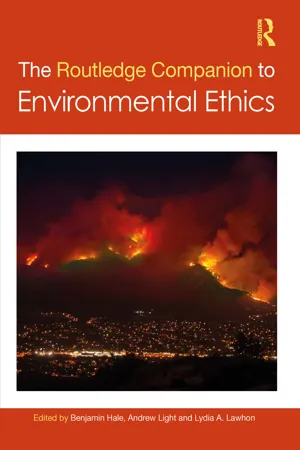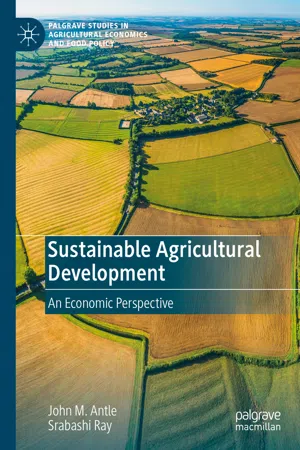Geography
Sustainability in Agriculture
Sustainability in agriculture refers to the practice of meeting current food production needs without compromising the ability of future generations to meet their own needs. It involves using farming methods that minimize environmental impact, conserve natural resources, and support the well-being of farmers and local communities. Sustainable agriculture aims to maintain the long-term health and productivity of the land while promoting economic viability and social equity.
Written by Perlego with AI-assistance
Related key terms
12 Key excerpts on "Sustainability in Agriculture"
- eBook - ePub
- Robert L Zimdahl(Author)
- 2010(Publication Date)
- Academic Press(Publisher)
a. Sustainability of production. Long-term food sufficiency, either domestic or worldwide. The practice of agriculture is the way the world is fed and economic cost-benefit analysis of agricultural science and technology is how one determines the best way to practice agriculture to sustain it and thus prevent massive starvation.b. Sustainability as stewardship. A primary concern for ecological balance and environmental quality. The proper quest is to create an agricultural system that preserves and conserves renewable resources while not polluting the environment or disrupting ecological balance on which life depends. Achieving sustainability is not a production question. It is a matter of knowing the ecological consequences of any production system and then minimizing the negative consequences. In Westra’s (1998 , p. 175 ) words, in regard to the earth’s natural systems, sustainability means maintaining “optimum, undiminished capacity for their time and location for sustained evolutionary development.”c. Sustainability as community. Sustainability is achieved by creating a set of agricultural practices, which encourage certain virtues that undergird the vitality of local communities. It is these practices which are to be preserved or reinstated. This view is similar to the second one, but emphasizes maintaining the “social organization and culture of rural life.”HIGHLIGHT 7.1“The essence of food and fiber production is that on one hand, the key production resources (seeds, tubers, soil, manures, and rain water) are renewable, thus potentially enabling agriculture to be a highly sustainable activity. On the other hand, agriculture has some actual or potential characteristics of an extractive industry, similar to mining, and accordingly has the potential to be highly unsustainable. In addition, food and fiber production may involve long-term non-environmental costs (e.g., impacts on workers, communities, regions, and consumers) to a greater or lesser degree” (Buttell, 2003 - eBook - ePub
Geographies of Agriculture
Globalisation, Restructuring and Sustainability
- Guy Robinson(Author)
- 2014(Publication Date)
- Routledge(Publisher)
et al., 1992). Farmers tended to focus on economic factors rather than environmental ones and did not recognise any need for reducing purchased inputs or energy use. This contrasted with academic views that stressed the core ecological aspects of sustainable agriculture, for example ‘the ability of the agro-ecosystem to maintain productivity when subject to a stress or shock’ (Conway, 1997, p. 177). The academic views also varied between academic disciplines, reflecting the need to formulate future policy on sustainability that encompasses a broad interpretation of the term.Cobb et al. (1999) identify three specific problems in defining sustainable agriculture:• The dificulty in determining what sustainable soil characteristics are, e.g. the elusive notions of soil resilience and soil health. • The debate over the role of biodiversity. • Failure of academic research to develop appropriate inter-disciplinary research on this topic.Despite these difficulties, it is agreed that sustainable agriculture is primarily an approach to agri-culture that balances agronomic, environmental, economic and social optima, as implied in the definition provided by Francis and Younghusband (1990):Sustainable agriculture is a philosophy based on human goals and on understanding the long-term impact of our activities on the environment and on other species. Use of this philosophy guides our application of prior experience and the latest scientific advances to create integrated, resource-conserving, equitable farming systems. These systems reduce environmental degradation, maintain agricultural productivity, promote economic viability in both the short- and long-term, and maintain stable rural communities and quality of life. - eBook - ePub
- Colin Sage(Author)
- 2011(Publication Date)
- Routledge(Publisher)
These two examples – managing pests and diseases, and soil fertility enhancement, both without reliance on chemicals – demonstrate not only that more sustainable technologies and practices exist, but that they generally outperform industrialised productivist methods especially when evaluated in terms of resource utilisation, resilience to external shocks and stress, human and environmental health, and even with regard to total food output. Agricultural sustainability consequently seeks to combine three core principles, as follows:- Ecologically sound: integrating natural processes such as nutrient cycling, nitrogen fixation, soil regeneration and pest management and by minimising the use of non-renewable inputs (pesticides and fertilisers).
- Economically viable: that farms produce sufficient food output capable of supporting the livelihoods of those engaged in production, but also recognise their multifunctional role as environmental stewards and as economic actors within local and regional economies.
- Socially just: those who produce food have rights to land, to appropriate technical support and to market opportunities; and this enhances social capital, self-reliance and growing cooperation in pursuit of food security for all.
These elements of a sustainable agriculture are common to a range of initiatives that have grown enormously in number over the past quarter-century all around the world, in North and South, from some of the richest to some of the poorest countries. Although the term “agro-ecology” is widely used, other labels are also applied to these sustainable agricultural initiatives, including low external input and sustainable agriculture (LEISA); organic or biological farming; and a variety of more “alternative” approaches including biodynamic agriculture and permaculture. For Thompson and Scoones: - eBook - ePub
Regenerating Agriculture
An Alternative Strategy for Growth
- Jules N. Pretty(Author)
- 2013(Publication Date)
- Routledge(Publisher)
When these components come together, farming becomes integrated, with resources used more efficiently and effectively. Sustainable agriculture, therefore, strives for the integrated use of a wide range of pest, nutrient, soil and water management technologies. These are integrated at farm level to give a strategy specific to the biophysical and socioeconomic conditions of individual farms. Sustainable agriculture aims for an increased diversity of enterprises within farms, combined with increased linkages and flows between them. By-products or wastes from one component or enterprise become inputs to another. As natural processes increasingly substitute for external inputs, so the impact on the environment is reduced.Can Sustainable Agriculture be Defined?
Although it is relatively easy to describe goals for a more sustainable agriculture, things become much more problematic when it comes to attempts to define sustainability: ‘everyone assumes that agriculture must be sustainable. But we differ in the interpretations of conditions and assumptions under which this can be made to occur’ (Francis and Hildebrand, 1989).A great deal of effort has gone into trying to define sustainability in absolute terms. Since the Brundtland Commission’s definition of sustainable development in 1987, there have been at least 70 more definitions constructed, each different in subtle ways, each emphasizing different values, priorities and goals. The implicit assumption is that it is possible to come up with a single correct definition, and each author presumably regards their effort as the best.But precise and absolute definitions of sustainability, and therefore of sustainable agriculture, are impossible. Sustainability itself is a complex and contested concept. To some it implies persistence and the capacity of something to continue for a long time. To others, it implies resilience and the ability to bounce back after unexpected difficulties. With regard to the environment, it involves not damaging or degrading natural resources. Others see it as a concept that means developmental activities simply take account of the environment. Economies are sometimes said to be sustainable if they carry on growing at the same rate or only if growth does not reduce the natural resource base. - eBook - ePub
Beyond Developmentality
Constructing Inclusive Freedom and Sustainability
- Debal Deb(Author)
- 2012(Publication Date)
- Routledge(Publisher)
Individual farmers and organizations have developed various models of organic farming systems, drawn essentially on different traditional farming techniques of indigenous cultures. These models, most of them site-specific, were developed and are being used in different parts of the world under the rubrics of ‘organic,’ ‘biodynamic,’ ‘biological,’ ‘regenerative’ and ‘ecological’ agriculture. The organic food and agriculture movement is gaining in strength, in spite of the monumental opposition of the agrochemical industry, whose economic existence depends on synthetic fertilizers and pesticides of every sort. The movement is gathering momentum in spite of the dominant view of agricultural development, as farmers are increasingly becoming aware that industrialized farming entails an ever-increasing production cost and rapidly declining soil fertility, crop yield and livelihood security.The general objectives of sustainable agricultural practices – to be economically viable, to meet human needs for food, to be environmentally positive, and to be concerned with quality of life – can be achieved in a number of different ways. Sustainable agriculture is not linked to any particular technological practice. Nor is sustainable agriculture the exclusive domain of organic farming. Rather, sustainable agriculture is thought of in the context of its adaptability and flexibility over time to respond to the demands of subsistence, its demands on natural resources for production, and its ability to protect the soil and the resources. This goal requires an efficient use of technology in a manner conducive to sustainability. Finally, because agriculture is affected by changes in market and resource decisions in other sectors and regions, it is important that these changes do not provide a rationale for unsustainable agricultural practices. The fundamental rationale of sustainable agriculture is that it must be based on ecological principles of production. The farming methodology is to produce crops in harmony with biodiversity – within and in association with the farm ecosystem – to make the production system ecologically adaptive, simulating and maintaining the natural biodiversity and complexity of natural ecosystems.Models of ecological agriculture show that the more biodiverse an agro-ecosystem, the more sustainable it becomes. Ecological farming systems operate on the principle of minimum perturbation to the farm ecosystem and make the utmost use of biodiversity in farm management (see Box 6.2 - eBook - ePub
The Spirit of the Soil
Agriculture and Environmental Ethics
- Paul B. Thompson(Author)
- 2017(Publication Date)
- Routledge(Publisher)
1 The diversity of interest groups issuing calls for sustainable agriculture and for sustainable development demonstrates that sustainability has become a contested concept.Although contradictory notions of sustainability often arise as a result of divergent interests and social goals, a deeper philosophical ambiguity is the focus of concern here. Rhetorically, at least, the concept of sustainability presents a way to frame the ethical questions about natural or ecological balance that might serve as an alternative to the ecocentric/anthropocentric dichotomy. Ecocentric language can specify duties to preserve or respect nature, but presents little guidance with respect to environments in which agriculture has already replaced the natural order. Anthropocentric language can specify duties to conserve resources for future use, but fails to build any concept of ecosystem integrity into the basis of moral obligation.2 It is at least superficially attractive to say that it is the sustainability of agricultural practice, or rural communities, or of the development process, that is the object of our moral duty. While the meaning of sustainability is contested by different political interests, it is a concept that promises to promote philosophical unity.It should be noted that many authors who have taken up the banner of sustainability seem quite content with language that specifies duties to avoid unwanted consequences for humans. David Pearce (1941–2005), for example, produced a series of studies on sustainability that are framed entirely within the anthropocentric perspective. These studies reframe many of the economic methods tied to the “true costs” way of thinking as components of a “blueprint” for sustainability.3 Writing with Edward Barbier and Anil Markandya, one of Pearce’s early efforts to define sustainable development begins by specifying a “development vector” that includes social objectives such as increasing per capita income, improving health and nutrition, education, and distributive justice. They write: “Sustainable development is then a situation in which the development vector D does not decrease over time.”4 - eBook - ePub
- Roger A. Professor Sedjo, Roger A. Professor Sedjo(Authors)
- 2010(Publication Date)
- Routledge(Publisher)
CHAPTER 4 The Sustainability of U.S. Cropland Soils Sandra S. Batie M ORE THAN 60 PERCENT of the 2.3 billion acres of land in the United States is in private ownership. Of this acreage, approximately 20 percent (442 million acres) is in cropland and 26 percent (587 million acres) is in permanent grassland pasture and range (Lubowski et al. 2006). The farms and ranches are managed by less than 2 percent of the population (Vesterby and Krupa 2001). The management of cropland soils not only influences food and fiber production but can also have a major impact on the quality of U.S. air and water, including such seemingly remote resources as shellfish beds in marine estuaries and global climate conditions. Thus, whether the current use of these agricultural soils is sustainable in the long run is worthy of close examination. However, sustainability is a concept that has many meanings, and the definition has evolved over time. At one time, soil sustainability primarily referred to the soil's ability to sustain or enhance crop yields over long periods (Frederick and Sedjo 1990). Thus, factors that influenced soil productivity, such as the basic fertility of the soil resource, as well as substitutes and complements for natural fertility, such as fertilizers, farm management techniques, and the availability of hybrid crops tailored for certain soils and climates, were examined closely. Recently, soil scientists have extended the concept of sustainable soils beyond crop production to include many other functions. High-quality soils can help maintain water quality, regulate water quantity, prevent water and wind erosion, improve nutrient cycling, buffer global climate changes via carbon sequestration, improve food nutrition and safety, enhance biodiversity and provide for nonagricultural uses, such as building sites (National Research Council 1993; Jaenicke 1998; Lal 1999; Schjonning et al - eBook - ePub
Sustainable Agricultural Chemistry in the 21st Century
Green Chemistry Nexus
- William Nelson(Author)
- 2023(Publication Date)
- CRC Press(Publisher)
The Ecological Footprint (EF) represents a measure of how human pressure on the environment is measured by the collective effects of human activities on the environment from all the production and consumption of goods and services expended to satisfy human needs. The cumulative effects provide the recorded results of the Anthropocene. The global practice of agriculture must include human development and meet sustainability criteria that enables food and all other agricultural ecosystem services (i.e., climate stabilization, flood control, support of mental health, nutrition, etc.) to be generated within a stable and resilient earth system, which in turn can be defined from earth science applying the planetary boundary framework. The means by which this can be achieved is through sustainable intensification of agriculture in the Anthropocene.Human sustainability will require maintaining a healthy balance with nature, including a high-quality food supply and general good health, which are fundamental needs that have to be satisfied if individuals within society are to attain a high standard of living. In the twenty-first century the efforts to guarantee a high quality of food are being done in tandem with heightened production to meet a growing world population. To truly accomplish this will require massive production values, which at present is harmonized with societal sustainability issues.[29 ]Sustainable intensification of agriculture (SIA) will be developed in the next chapter , but an introduction is given here. Since agriculture plays a central role in determining and regulating earth’s resilience, the sustainability methodology is needed for agriculture. Adopting SIA as the strategy to meet twin objectives for people and the planet is an imperative. Agriculture is the key to attaining the UN Sustainable Development Goals of eradicating hunger and securing food for the projected world population of 9–10 billion by 2050. This may require an increase in global food production of between 60 and 110 % in a world of rising global environmental risks.[30 - eBook - ePub
Farming in Nature's Image
An Ecological Approach To Agriculture
- Judy Soule, Jon Piper(Authors)
- 2013(Publication Date)
- Island Press(Publisher)
Finally, it is important to acknowledge openly that values and beliefs do indeed influence technology and the science that supports and develops that technology. Belief in the ultimate propriety of competition and the correctness of efficiency and profit built the foundations of today’s highly productive, labor-efficient, yet unsustainable agriculture. This view seemed to fit in a world of abundant resources and rapid growth. Today, however, humanity is coming up against global limits to growth. Many signs indicate that the planet is rapidly reaching or even exceeding its capacity to sustain the industrial human species. Acid rain, the thinning of the stratospheric ozone layer, soil erosion, an increase of atmospheric carbon dioxide, and many other phenomena indicate that humans are taxing the ecosphere’s resiliency and stability. It is becoming evident that we all must learn to live in something like a steady state, an equilibrium on Earth, and reduce practices that tax the planet’s recycling and renewal capacities. The agriculture that seemed to fit during our growth phase no longer makes any sense.Of course, agriculture is only a small contributor to many of these global problems, yet it is a major contributor to some—for example, degraded and depleted water supplies. Moreover, industrialized agriculture is inconsistent with the steady-state model, dependent as it is on wasting soil and water resources, using nonrenewable fossil fuels, and broadcasting toxic wastes.To acknowledge openly that what is needed is to replace the values and beliefs on which modern agriculture was founded with values and beliefs that support a steady-state relationship between humans and the earth is a major step toward developing sustainable agriculture. And although the word sustainability is getting more media attention, it is still often used in the context of growth and increased production. In an article titled “The Ecology of Sustainable Development,” William Rees complained that the meaning of the term sustainable development - eBook - ePub
Cultural Sustainability and the Nature-Culture Interface
Livelihoods, Policies, and Methodologies
- Inger Birkeland, Rob Burton, Constanza Parra, Katriina Siivonen, Inger Birkeland, Rob Burton, Constanza Parra, Katriina Siivonen(Authors)
- 2018(Publication Date)
- Routledge(Publisher)
Furthermore, the social practice approach applied in this study enables us to elaborate on the relationship between nature and culture in cultural sustainability. At first glance, nature is present in the material element of the social practice framework, conditioning the practices as well as the culture that the practices represent. Continuity, diversity and fertility exist in relation to nature. However, by being part of the practices, nature becomes part of culture, for example, in fertility practices, which are directed at looking after and maintaining soil and the natural environment. The meanings and competences, that are elements of the social practice framework, are defined in relation to nature. Furthermore, as fertility is practiced, nature in the form of soil is (re)produced. Yet, this reproduction of nature does not mean that nature becomes subsumed by culture. Farming practices can never totally control nature, but nature always conditions human practices. Hence, the focus on farming practices discussed in this chapter points out how nature and culture are in a dynamic relationship in defining cultural sustainability. The rationalization and appreciation processes conditioning the practices help to unpack this dynamic to reflect on the nature–culture interface. From a sustainability perspective, the critical point is, however, where the dynamics induced in the nature–culture interface is leading to. Cultural sustainability requires rationalization and appreciation to be able to maintain capability and resilience.In this chapter, we have explored the relationship between agriculture and cultural sustainability. We conclude that agriculture as a model of sustainable agricultural practices informs our understanding of cultural sustainability. It is able to clarify the connections between the humans and the nature and conditions for a creating a new Natural Contract (cf. Serres, 1995) that is urgently needed in our times.Acknowledgements
Dr Michiel de Kromm and Dr Joost Dessein contributed to this manuscript by designing the overall idea. The contribution of Suvi Huttunen was funded by the Academy of Finland, decision 277896.References
Allen, P., Van Dusen, D., Lundy, J. and Gliessman, S. (1991) Integrating social, environmental, and economic issues in sustainable agriculture. American J. Alternative Agriculture - eBook - ePub
- Benjamin Hale, Andrew Light, Lydia Lawhon, Benjamin Hale, Andrew Light, Lydia Lawhon(Authors)
- 2022(Publication Date)
- Routledge(Publisher)
Finally, illusory dichotomies pervade sustainable agriculture. One important split occurs between humans and environment. The work of making agriculture sustainable invariably takes place within an anthropocentric frame. For example, farmers deserve a fair return on the time, knowledge, and labor that they dedicate to their land, rather than being subjugated to impersonal market forces demanding the lowest possible cost. Protecting ecosystem services such as pollination and water cycling will maintain production of food, fiber, and fuel primarily for human benefit. In contrast, a biocentric perspective emphasizes the rights and existence of animals and ecosystems within and beyond the agricultural system. Animals are exploited on an enormous scale in industrial agriculture, while they are deprived of habitat through land clearing. Ecosystem functions are weakened, resulting in greater species vulnerability, and in biosphere decline. Complicating this seeming divide is the tendency of both agriculture and ecology to blot ‘culture’ out altogether. This denies the dynamic social-ecological interactions that have shaped agriculture from the very beginnings of crop domestication. There is no agriculture without culture; there is no ecological landscape that farmers have not reworked. Both ecological and human life should be integrated together through recognizing this biocultural heritage.The following selective examples give a sense of the breadth of ethical conundrums that can arise in sustainable agriculture, and the themes that need to be considered.Farming Methods: Sustainable Intensification and Agroecology
A key battleground features the types of agriculture used across the world. One example of how scientists, governments, industry, and farmers contest farming methods is through the rivaling philosophies of sustainable intensification and agroecology. Over the past decade, ‘sustainable intensification’ has appeared as a popular idiom in national and international policy circles. In 2009, the Royal Society in Britain published a prominent report that defined sustainable intensification as “agriculture in which yields are increased without adverse environmental impact and without the cultivation of more land” (Royal Society 2009 - eBook - ePub
Sustainable Agricultural Development
An Economic Perspective
- John M. Antle, Srabashi Ray(Authors)
- 2020(Publication Date)
- Palgrave Macmillan(Publisher)
health of consumers and the general public.3.6 Methods, Data, and Models to Assess Agricultural System Sustainability
A variety of quantitative tools are used to study tradeoff s in agricultural systems. The key analytical challenge is to predict changes in the sustainability indicators used to represent the performance of farm household systems. A major methodological challenge is to evaluate the performance of these systems when they are modified in some way, for example, when a new crop or crop variety is introduced into the system, or the farm household chooses to work less on the farm and more in other activities.Evaluating the performance of farm household systems is challenging for several reasons. First, agricultural system complexity means that it is difficult—if not impossible—to use conventional experimental methods (often referred to as randomized controlled trials [RCTs]) to study farm household systems because the same farms cannot be observed doing two or more different things at the same time. Whereas an agronomist can carry out a yield trial for a new crop and make side-by-side comparisons of, say, an old variety and a new variety, it is very costly and fraught with other practical and ethical difficulties to do this with actual farm household s (Barrett and Carter 2010 ). For example, when farmers adopt a new crop variety, they may make a number of changes in related management practices, the farm household might change its food consumption behavior, and so on. Thus, it is largely impractical to use the standard experimental design methods to carry out RCTs to study the sustainability of farm household systems, although some experimental data, such as agronomic trials, and also some behavioral experiments , can provide useful information. Another reason why conventional field experiments are often not used to study system sustainability is because such trials are extremely slow, because they can only proceed as fast as crops and livestock
Index pages curate the most relevant extracts from our library of academic textbooks. They’ve been created using an in-house natural language model (NLM), each adding context and meaning to key research topics.
